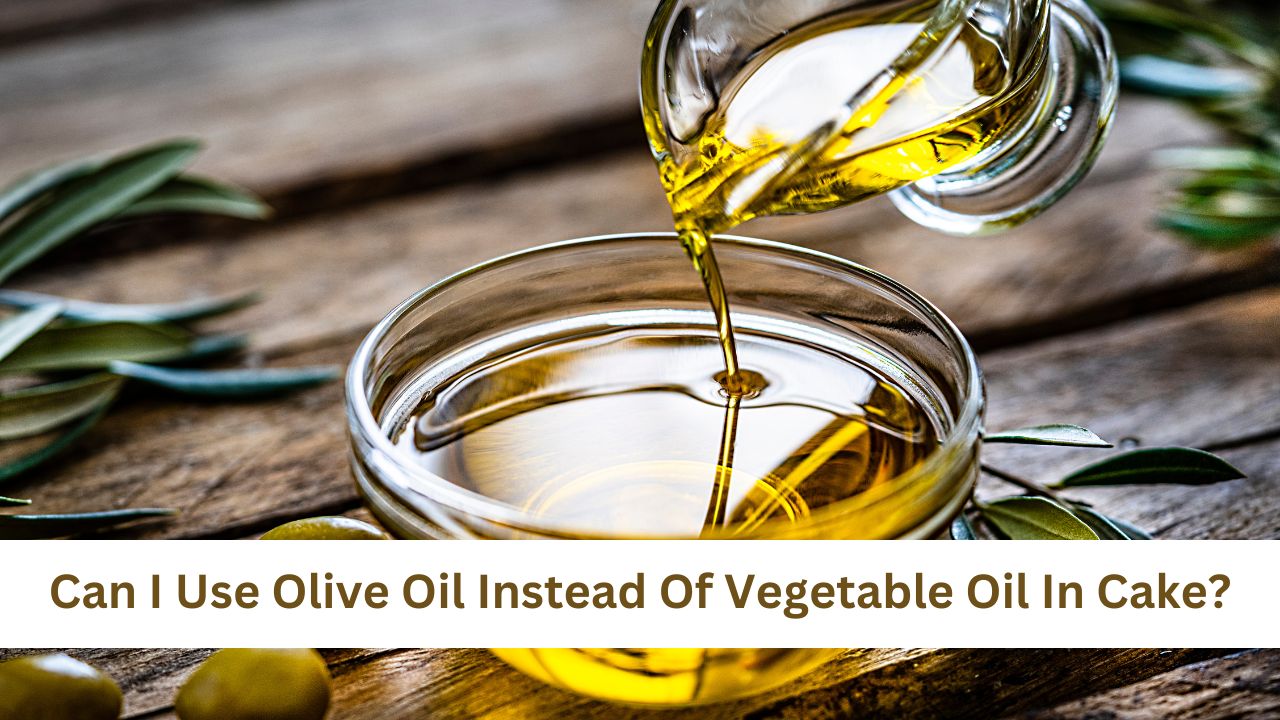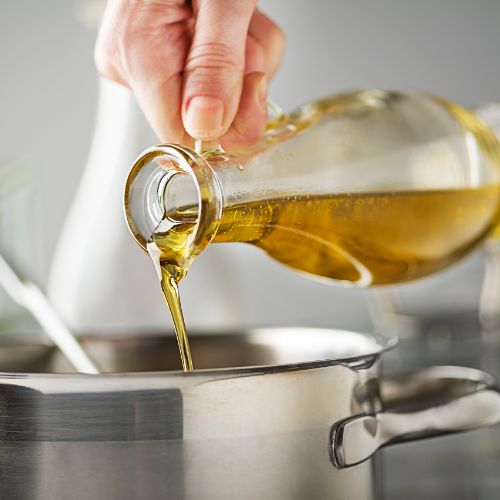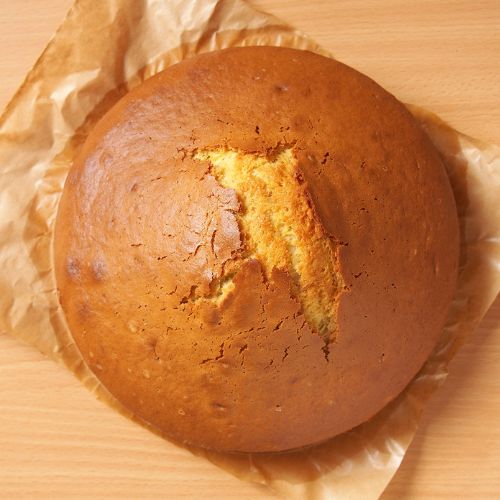Can I Use Olive Oil Instead Of Vegetable Oil In Cake?
When it comes to baking cakes, oil plays a crucial role in creating moist, tender, and flavorful results. Oil contributes to the texture and structure of the cake by providing moisture and preventing the formation of gluten strands, resulting in a softer and more delicate crumb. It also helps to distribute the heat evenly, leading to a more even and consistent baking process.
Vegetable oil is the go-to choice in many traditional cake recipes due to its neutral flavor and versatility. Vegetable oils, such as canola, sunflower, or soybean oil, are readily available and have a high smoke point, making them suitable for baking at high temperatures. Moreover, they are generally more affordable than other types of oils, making them a popular option for home bakers.
Can I use olive oil instead of vegetable oil in cake?

However, as the culinary world continues to evolve and people become more adventurous with their ingredients, the question arises: Can I use olive oil instead of vegetable oil in cake? Olive oil is known for its distinct flavor and health benefits, but does it work well in cake recipes? In this blog post, we will explore the potential of substituting olive oil for vegetable oil in cakes, understand the differences between the two oils, and provide insights on how to achieve successful results while maintaining the integrity of your cake.
The differences between vegetable oil and olive oil
Vegetable oil is a broad term used to describe various oils derived from plant sources. It is typically a blend of oils such as canola, soybean, sunflower, or corn oil. Vegetable oils are known for their neutral flavor, high smoke point, and versatility in cooking and baking. They are refined oils, which means they undergo processing methods such as extraction, refining, and sometimes hydrogenation.
On the other hand, olive oil is obtained from pressing olives, the fruit of the olive tree. It is a natural product, known for its distinct flavor and unique characteristics. Olive oil is available in different types, each with its own production methods and flavor profiles.
Types of olive oil (extra virgin, virgin, refined)

- Extra Virgin Olive Oil (EVOO): Extra virgin olive oil is the highest quality and most flavorful type of olive oil. It is extracted from the olives using mechanical means, without the use of chemicals or excessive heat. EVOO has a low acidity level, typically below 0.8%, and is known for its fruity, grassy flavors and peppery finish. It is often preferred for drizzling over salads or using as a finishing oil due to its robust taste.
- Virgin Olive Oil: Virgin olive oil is also extracted through mechanical means, similar to extra virgin olive oil. However, it has a slightly higher acidity level, usually between 0.8% and 2%. Virgin olive oil retains some of the flavor characteristics of extra virgin olive oil but is milder in taste. It can be used for cooking, sautéing, and baking.
- Refined Olive Oil: Refined olive oil is produced from olive oil that has undergone refining processes to remove any defects or impurities. It has a higher smoke point compared to extra virgin and virgin olive oil, making it more suitable for high-heat cooking methods. Refined olive oil has a milder flavor and is often blended with virgin or extra virgin olive oil for a balance of taste and affordability.
Characteristics Of Each Oil

- Vegetable Oil: Vegetable oil has a neutral flavor and aroma, allowing the other ingredients in the cake to shine. It provides moisture and contributes to a light and tender texture. Its main purpose is to act as a carrier for the flavors in the cake.
- Extra Virgin Olive Oil: Extra virgin olive oil has a distinct fruity, grassy flavor with hints of bitterness and peppery notes. It can add depth and complexity to the taste of the cake, especially in recipes that complement its robust flavor profile.
- Virgin Olive Oil: Virgin olive oil has a milder flavor than extra virgin olive oil but retains some fruitiness and herbal notes. It imparts a subtle olive oil taste to the cake while allowing other flavors to come through.
- Refined Olive Oil: Refined olive oil has a mild flavor and aroma, with minimal olive oil characteristics. It provides moisture to the cake without overpowering the other flavors. Its primary advantage lies in its higher smoke point, making it suitable for baking at higher temperatures.
Substituting Olive Oil for Vegetable Oil in Cake
Olive oil can be successfully used as a substitute for vegetable oil in cake recipes, but it’s important to consider the compatibility of the flavors and textures. The distinct taste of olive oil may not work well in all cake varieties. However, in certain recipes like citrus-flavored cakes or chocolate cakes, the fruity and robust flavors of olive oil can complement the overall taste profile.
How Olive Oil Affects The Flavor And Texture Of Cakes
- Flavor: Olive oil adds a unique and characteristic flavor to cakes. The flavor can range from fruity and grassy to peppery and slightly bitter, depending on the type of olive oil used. This can enhance the overall taste of the cake, particularly when paired with complementary flavors. However, if the flavor of olive oil is too strong for a particular cake recipe, it’s advisable to use a milder version or a combination of olive oil and another neutral oil.
- Texture: Olive oil contributes to the moisture and tenderness of cakes. It can result in a slightly denser crumb and a more moist texture compared to cakes made with vegetable oil. The presence of natural fats in olive oil also helps keep the cake moist for longer. However, the texture may vary depending on the type of olive oil used, so it’s important to choose the right one for the desired outcome.
Substituting Olive Oil For Vegetable Oil
Conversion ratios (1:1 or adjusted ratios)
In most cases, olive oil can be substituted for vegetable oil using a 1:1 ratio. This means if a recipe calls for 1 cup of vegetable oil, you can use 1 cup of olive oil instead. However, if you prefer a milder olive oil flavor or if the cake recipe is more delicate, you can start by using 3/4 cup of olive oil for every 1 cup of vegetable oil and adjust accordingly based on personal preference.
Considering the type and quality of olive oil
The type and quality of olive oil used can greatly impact the flavor and outcome of the cake. For recipes where the flavor of olive oil is intended to shine, extra virgin or virgin olive oil is recommended. Refined olive oil can be used for recipes with a milder flavor. It’s important to choose a high-quality olive oil that is fresh and has a pleasant taste.
Adjustments for flavor and aroma
If you find the flavor of olive oil too strong or overpowering in a particular cake recipe, you can make a few adjustments: a. Use a milder version of olive oil or a combination of olive oil and another neutral oil. b. Add complementary flavors that pair well with olive oil, such as citrus zest, vanilla, or spices, to balance out the taste. c. Experiment with different olive oil varieties to find the one that best suits your taste preferences and the specific cake recipe.
Benefits of Using Olive Oil in Cake

Olive oil is renowned for its numerous health benefits, and incorporating it into your cake recipes can provide additional advantages compared to traditional vegetable oils. (source: Healthline)
- Heart-healthy properties: Olive oil is rich in monounsaturated fats, which have been associated with improving heart health. These healthy fats can help reduce bad cholesterol levels and promote good cholesterol, which is beneficial for cardiovascular health.
- Antioxidant content: Olive oil contains powerful antioxidants, such as polyphenols, which help protect the body against oxidative stress and inflammation. These antioxidants contribute to overall well-being and may positively affect various aspects of health.
- Anti-inflammatory effects: The natural compounds found in olive oil, including oleocanthal, have been shown to possess anti-inflammatory properties. By reducing inflammation in the body, olive oil may contribute to better overall health and potentially help prevent chronic diseases.
- Vitamins and minerals: Olive oil contains essential vitamins and minerals, including vitamins E and K, which benefit skin health, bone strength, and immune function.
Rich Flavor And Aroma Olive Oil Brings To Cakes
One of the significant advantages of using olive oil in cakes is the rich flavor and aroma it imparts. Unlike neutral vegetable oils, olive oil adds a distinct and delightful taste profile to your baked goods.
- Fruity and herbaceous notes: Depending on the type of olive oil you choose, such as extra virgin or virgin olive oil, the cake can develop a fruity, grassy, or peppery flavor. This complexity adds depth and sophistication to the overall taste experience.
- Complementary flavors: Olive oil pairs exceptionally well with other ingredients, such as citrus fruits, chocolate, nuts, and spices. It can elevate the flavors of these ingredients and create a harmonious balance that tantalizes the taste buds.
- Culinary versatility: Olive oil is a staple in Mediterranean cuisine and is renowned for its ability to enhance the flavors of a wide range of dishes. By incorporating olive oil into your cake recipes, you can infuse your baked goods with a touch of Mediterranean flair and capture the essence of this culinary tradition.
Potential For Enhanced Moisture And Tenderness In Cakes
In addition to the flavor benefits, using olive oil in cakes can contribute to enhanced moisture and tenderness.
- Moisture retention: Olive oil contains natural fats that help retain moisture in baked goods. This can result in cakes that stay moist for longer periods, even days after baking. The moisture retention properties of olive oil are particularly beneficial for cakes that have a longer shelf life or need to be stored before serving.
- Tender texture: Olive oil contributes to a tender and delicate crumb in cakes. It helps prevent the development of gluten strands, resulting in a lighter texture. Cakes made with olive oil often have a softer, melt-in-your-mouth quality that is highly desirable.
- Improved shelf life: Due to its inherent qualities, such as the presence of antioxidants, olive oil can contribute to extending the shelf life of cakes. It helps slow down the staling process and maintains the freshness and quality of the cake over time.
By using olive oil in your cake recipes, you not only introduce a range of health benefits but also enhance the overall flavor, aroma, moisture, and tenderness of your baked creations. It’s a wholesome and flavorful choice that can elevate your baking endeavors.
Tips for Using Olive Oil in Cake
While using olive oil in cakes can yield delicious results, there are a few potential challenges to consider:
- Strong flavor: The distinct flavor of olive oil may not be suitable for all cake recipes. Some delicate or light-flavored cakes may be overwhelmed by the robust taste of certain olive oils. It’s essential to choose the right type and quality of olive oil that complements the flavors in the cake.
- Texture variations: Different types of olive oil can affect the texture of cakes differently. Extra virgin olive oil, for example, has a thicker consistency and may result in a denser texture compared to cakes made with vegetable oil. Refined olive oil, on the other hand, may lead to a lighter texture. Understanding the characteristics of the specific olive oil being used can help manage any potential texture variations.
Selecting The Right Olive Oil For Baking

When selecting olive oil for baking, consider the following tips:
- Choose a quality oil: Opt for high-quality olive oil to ensure the best cake flavor and performance. Look for reputable brands or seek out local producers known for their quality oils.
- Consider the flavor profile: Match the flavor profile of the olive oil with the desired taste of your cake. Opt for virgin or refined olive oil if you prefer a milder flavor. If you want a more pronounced olive oil taste, select a good-quality extra virgin olive oil.
- Freshness matters: Check the expiration date and packaging information to ensure fresh olive oil. Fresher oils tend to have better flavors and nutritional content.
- Taste and test: If you’re uncertain about the flavor of a particular olive oil, do a small taste test before using it in your cake recipe. This will give you an idea of the oil’s flavor profile and help you determine if it suits your baking needs.
Complementary Flavors and Ingredients for Olive Oil-Based Cakes
To enhance the flavors of olive oil-based cakes, consider incorporating complementary ingredients:
- Citrus zest: Citrus flavors, such as lemon or orange zest, work particularly well with the fruity and herbal notes of olive oil. They add brightness and a refreshing element to the cake.
- Nuts: Walnuts, almonds, or pistachios can add texture and depth to olive oil-based cakes. Their earthy flavors complement the richness of the olive oil.
- Chocolate: Olive oil pairs wonderfully with dark chocolate, creating a decadent and indulgent combination. Consider incorporating cocoa powder or melted chocolate into your olive oil-based cake recipe.
- Herbs and spices: Experiment with herbs like rosemary or thyme, or spices like cinnamon or cardamom, to add complexity and aromatic undertones to your olive oil-based cakes.
By combining these complementary flavors and ingredients, you can further enhance the taste and overall experience of your olive oil-based cakes, creating unique and delightful treats.
By being mindful of potential challenges, selecting the right olive oil, and incorporating complementary flavors, you can confidently use olive oil in your cake recipes and create delectable and distinctive baked goods that showcase the versatility and richness of this Mediterranean ingredient.
Cake Recipes Using Olive Oil Instead Of Vegetable Oil

- Lemon Olive Oil Cake:
- Technique: Start by whisking together the wet ingredients, including extra virgin olive oil, freshly squeezed lemon juice, lemon zest, and eggs. In a separate bowl, combine the dry ingredients. Gradually add the dry mixture to the wet ingredients, alternating with milk. Bake the cake in a preheated oven until golden and a toothpick inserted comes out clean.
- Adjustments: To balance the acidity of the lemon and the flavor of olive oil, you may want to use a milder olive oil or a combination of olive oil and vegetable oil. Adjust the sweetness level by adding more or less sugar, depending on your preference.
- Chocolate Olive Oil Cake:
- Technique: Melt dark chocolate and combine it with extra virgin olive oil. In a separate bowl, whisk together eggs, sugar, and vanilla extract. Add the chocolate mixture to the egg mixture and combine. Gradually add the dry ingredients, alternating with milk. Bake the cake until a toothpick inserted in the center comes out with a few crumbs.
- Adjustments: Choose a high-quality extra virgin olive oil with a balanced flavor. Adjust the sweetness by adjusting the amount of sugar used. You can also experiment with adding a hint of espresso powder or spices like cinnamon for additional depth of flavor.
- Orange Almond Olive Oil Cake:
- Technique: In a food processor, pulse together almonds and sugar until finely ground. In a separate bowl, whisk together extra virgin olive oil, orange zest, orange juice, eggs, and almond extract. Add the almond mixture to the wet ingredients and combine. Gradually add the dry ingredients, alternating with milk. Bake the cake until golden and a toothpick comes out clean.
- Adjustments: Select a mild extra virgin olive oil that complements the orange and almond flavors. For a gluten-free version, substitute the all-purpose flour with almond flour or a gluten-free flour blend. Adjust the sweetness level based on personal preference.
- Rosemary Olive Oil Cake:
- Technique: In a saucepan, heat olive oil with fresh rosemary sprigs to infuse the flavors. Once cooled, remove the rosemary sprigs. In a bowl, whisk together eggs, sugar, and vanilla extract. Add the infused olive oil, flour, baking powder, and salt. Bake the cake until a toothpick comes out clean. Optional: Prepare a rosemary-infused glaze to drizzle over the cooled cake.
- Adjustments: Choose a medium-bodied olive oil that pairs well with the herbal notes of rosemary. Adjust the amount of rosemary based on personal taste preferences. Experiment with adding lemon zest or a touch of lemon juice for a citrusy twist.
Tips And Recommendations For Successful Outcomes

- Use high-quality olive oil: The quality and freshness of the olive oil will greatly impact the flavor of the cake. Choose a reliable brand or consider using locally sourced olive oil.
- Measure accurately: Accurate measurements of ingredients are crucial for successful baking. Use measuring cups and spoons to ensure precision.
- Allow ingredients to reach room temperature: Allowing eggs and other refrigerated ingredients to come to room temperature helps with better incorporation and even baking.
- Grease and flour pans properly: Properly greasing and flouring the cake pans will help prevent sticking and ensure easy release of the baked cake.
- Monitor baking time: Keep a close eye on the cake while it’s baking. Baking times may vary depending on your oven. Use a toothpick or cake tester to check for doneness.
- Cool the cake properly: Allow the cakes to cool in the pans for a few minutes before transferring them to a wire rack to cool completely. This helps the cakes set and maintain their shape.
- Experiment with toppings: Consider adding a dusting of powdered sugar, a drizzle of glaze, or a dollop of whipped cream to enhance the presentation and taste of your olive oil cakes.
By following these techniques, making adjustments when necessary, and applying the provided tips and recommendations, you can achieve successful outcomes when baking cakes using olive oil. These recipes will showcase the versatility and unique flavors that olive oil brings to your homemade treats.